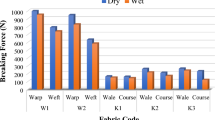Abstract
Layered fabric systems with electrospun polyurethane fiber web layered on spunbonded nonwoven were developed to examine the feasibility of developing protective textile materials as barriers to liquid penetration using electrospinning. Barrier performance was evaluated for layered fabric systems, using pesticide mixtures that represent a range of surface tension and viscosity. Air permeability and water vapor transmission were assessed as indications of thermal comfort performance. Protection performance and air/moisture vapor transport properties were compared for layered fabric systems and existing materials for personal protective equipment (PPE). Layered fabric systems with electrospun nanofiber web showed barrier performance in the range between microporous materials and nonwovens used for protective clothing. Layered fabric structures with the web area density of 1.0 and 2.0 g/m2 exhibited air permeability higher than most PPE materials currently in use; moisture vapor transport was in a range comparable to nonwovens and typical woven work clothing fabrics. Comparisons of layered fabric systems and currently available PPE materials indicate that barrier/transport properties that may not be attainable with existing PPE materials could be achieved from layered fabric systems with electrospun nanofibrous web.
Similar content being viewed by others
References
S. Lee and S. K. Obendorf,J. Text. Inst.,98, 87 (2007).
S. Lee and S. K. Obendorf,Arch. Environ. Contam. Toxicol.,49, 266 (2005).
P. Gibson, H. Schreuder-Gibson, and D. Rivin,Colloids. Surf. Physicochem. Eng. Aspect.,187, 469 (2001).
J.-S. Kim and D. H. Reneker,Polym. Compos.,21, 124 (1999).
W.-J. Li, C. T. Laurencin, E. J. Caterson, R. S. Tuan, and F. K. Ko,J. Biomed. Mater. Res. Part A,60, 613 (2002).
X. Wang, C. Drew, S.-H. Lee, K. J. Senecal, J. Kumar, and L. A. Samuelson,J. Macromol. Sci. Part A,A39, 1251 (2002).
A. Buer, S. C. Ugbolue, and S. B. Warner,Text. Res. J.,71, 323 (2001).
J. M. Deitzel, J. Kleinmeyer, D. Harris, and N. C. Beck Tan,Polymer,42, 261 (2001).
H. Schreuder-Gibson, P. Gibson, K. Senecal, M. Sennett, J. Walker, W. Yeomans, D. Ziegler, and P. P. Tsai,J. Adv. Mater.,34, 44 (2002).
S. Lee and S. K. Obendorf,J. Appl. Polym. Sci.,102, 3430 (2006).
S. Lee and S. K. Obendorf,Text. Res. J., in press.
S. Lee and S. K. Obendorf,Text. Res. J.,71, 1000 (2001).
K. H. Lee, H. Y. Kim, Y. J. Ryu, K. W. Kim, and S. W. Choi,J. Polym. Sci. Part B: Polym. Phys.,41, 1256 (2003).
A. Pedicini and R. J. Farris,Polymer,44, 6857 (2003).
D. Li, M. W. Frey, and Y. L. Joo,J. Membr. Sci.,286, 104 (2006).
Author information
Authors and Affiliations
Corresponding author
Rights and permissions
About this article
Cite this article
Lee, S., Obendorf, S.K. Transport properties of layered fabric systems based on electrospun nanofibers. Fibers Polym 8, 501–506 (2007). https://doi.org/10.1007/BF02875872
Received:
Revised:
Accepted:
Issue Date:
DOI: https://doi.org/10.1007/BF02875872




